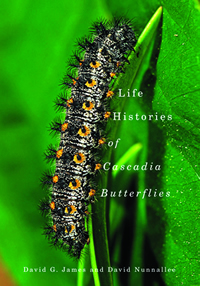 When first picking up the fascinating Life Histories of Cascadia Butterflies, I expected lots of lovely close-up photographs of our native butterflies. While I wasn’t disappointed, the majority of the photos are of the early stages of their life histories, i.e., lots of caterpillars! The thoroughness for depicting each species is outstanding with typically five or more photos of the different larval stages. How did authors David James and David Nunnallee do it? By rearing the butterflies from eggs and photographing each stage of their development.
When first picking up the fascinating Life Histories of Cascadia Butterflies, I expected lots of lovely close-up photographs of our native butterflies. While I wasn’t disappointed, the majority of the photos are of the early stages of their life histories, i.e., lots of caterpillars! The thoroughness for depicting each species is outstanding with typically five or more photos of the different larval stages. How did authors David James and David Nunnallee do it? By rearing the butterflies from eggs and photographing each stage of their development.
Robert Michael Pyle wrote the Foreword and he best describes the enormous scale of this work: “…this book is the apex of life history treatments to date. In the whole world, no other comparable region enjoys a work of this scale, ambit, and acuity for its butterfly fauna”.
Excerpted from the Fall 2012 Arboretum Bulletin.
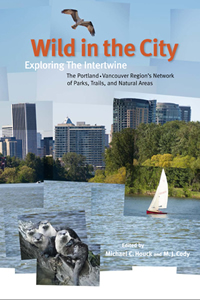 Wild in the City is an invaluable guide for an exploration of the parks and trails in the Portland metropolitan area, but it’s quite readable even if you’re stuck somewhere else. Scattered amongst the trail maps and descriptions of various sites and walks are essays about wildlife, history–both natural and human–and the complexities of disturbed ecosystems, with a good dose of philosophy on the value of having nature in an urban setting. Over one hundred writers and illustrators have contributed to this fine work.
Wild in the City is an invaluable guide for an exploration of the parks and trails in the Portland metropolitan area, but it’s quite readable even if you’re stuck somewhere else. Scattered amongst the trail maps and descriptions of various sites and walks are essays about wildlife, history–both natural and human–and the complexities of disturbed ecosystems, with a good dose of philosophy on the value of having nature in an urban setting. Over one hundred writers and illustrators have contributed to this fine work.
Excerpted from the Fall 2012 Arboretum Bulletin.
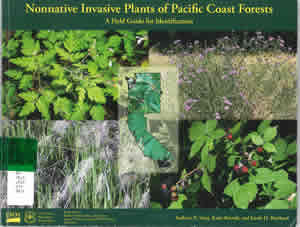 Nonnative Invasive Plants of Pacific Coast Forests is an unusual field guide that helps to identify plants you don’t want to find–but you probably will–especially in the forests of Washington, Oregon, and California. In various ways, these plants are negatively affecting our native plants, animals, and ecosystems. The intent of the authors is to make these recognizable to a larger audience beyond highly trained botanists. Many selections, such as purple loosestrife (Lythrum salicaria) and herb-robert (Geranium robertianum), are all too familiar to gardeners and visitors to the Arboretum. Others will be less familiar, or you might not know they are a problem, such as some of our popular cotoneasters (Cotoneaster franchetii and C. lacteus).
Nonnative Invasive Plants of Pacific Coast Forests is an unusual field guide that helps to identify plants you don’t want to find–but you probably will–especially in the forests of Washington, Oregon, and California. In various ways, these plants are negatively affecting our native plants, animals, and ecosystems. The intent of the authors is to make these recognizable to a larger audience beyond highly trained botanists. Many selections, such as purple loosestrife (Lythrum salicaria) and herb-robert (Geranium robertianum), are all too familiar to gardeners and visitors to the Arboretum. Others will be less familiar, or you might not know they are a problem, such as some of our popular cotoneasters (Cotoneaster franchetii and C. lacteus).
Excerpted from the Fall 2012 Arboretum Bulletin.
 Many of the over 7,000 vascular plant species of California described in The Jepson Manual can also be found in the Pacific Northwest.
Many of the over 7,000 vascular plant species of California described in The Jepson Manual can also be found in the Pacific Northwest.
The name perhaps needs clarification. Willis Linn Jepson was an early 20th century botanist who published several books on California flora, including the first that was both comprehensive and statewide for vascular plants (“A Manual of the Flowering Plants of California”–1925). The 1993 first edition of “The Jepson Manual” honored his memory, and this new edition continues that honor while incorporating new discoveries and the many changes in botanical systematics of the last twenty years.
Excerpted from the Fall 2012 Arboretum Bulletin.
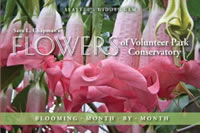 Flowers of Volunteer Park Conservatory is one of the best examples I’ve seen of a book capturing the spirit of a public garden. Photographer Sara L. Chapman has created monthly visual essays, using both close-ups and panoramas to bring you into the page and remind you of a real life visit. But this is more than just a picture book. The subjects of the photos are carefully captioned, making this a useful identification handbook to conservatory plants.
Flowers of Volunteer Park Conservatory is one of the best examples I’ve seen of a book capturing the spirit of a public garden. Photographer Sara L. Chapman has created monthly visual essays, using both close-ups and panoramas to bring you into the page and remind you of a real life visit. But this is more than just a picture book. The subjects of the photos are carefully captioned, making this a useful identification handbook to conservatory plants.
Excerpted from the Fall 2012 Arboretum Bulletin.
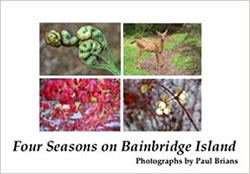 Four Seasons on Bainbridge Island is a photo essay by Paul Brians celebrating the flora of the island, some from his own garden, and accented with a few shots of people, animals, and landscapes. Highly recommended for residents of Bainbridge, this book also captures the essence of semi-rural, island living anywhere around Puget Sound.
Four Seasons on Bainbridge Island is a photo essay by Paul Brians celebrating the flora of the island, some from his own garden, and accented with a few shots of people, animals, and landscapes. Highly recommended for residents of Bainbridge, this book also captures the essence of semi-rural, island living anywhere around Puget Sound.
Excerpted from the Fall 2012 Arboretum Bulletin.
Photos of the Union Bay Natural Area (UBNA) can be found in “Seasons of Life in the Union Bay Sanctuary” by Marilyn Smith Layton. This photo essay includes not only birdlife, but also landscapes, flowers, trees, and the people who come to observe it all.
Excerpted from the Fall 2012 Arboretum Bulletin.
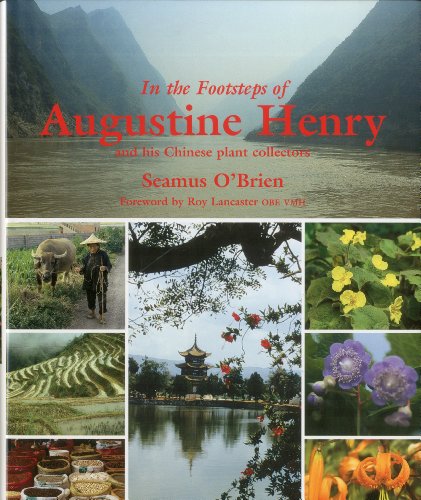 While you’re browsing the tables at your favorite plant sale or nursery, you may notice that many of the plant treasures tempting you have “henryi” or some similar variation in their name. In most cases, these honor Augustine Henry, the Irish customs official who worked for the Chinese government in western China during the 1880s and 1890s.
While you’re browsing the tables at your favorite plant sale or nursery, you may notice that many of the plant treasures tempting you have “henryi” or some similar variation in their name. In most cases, these honor Augustine Henry, the Irish customs official who worked for the Chinese government in western China during the 1880s and 1890s.
Henry was not sent there to collect plant specimens, but that was his passion, and his day job allowed him far greater access than most outsiders had to the rich flora of the countryside. His discoveries and his tireless efforts to share those discoveries—through his letters and the seeds, bulbs, and dried plant specimens he sent back to Europe—led to many, many important plants being introduced to western horticulture.
My excitement over Henry was sparked by my recent reading of In the Footsteps of Augustine Henry and his Chinese plant collectors by Seamus O’Brien. The author not only tells the history of his fellow Irishman, he also tells of his own recent expeditions to the areas that Henry explored, especially those that were soon after destroyed by the rising waters of the Three Gorges Dam.
You can join in celebrating Henry by buying some of his plants, including Lilium henryi, Parthenocissus henryana (Silvervein Creeper), and Rhododendron augustinii. Other plants introduced because of his research—and the enthusiasm for the plants of western China that his research sparked—include Acer griseum (Paperbark Maple), Davidia involucrata (Dove Tree), and Hamamelis mollis (Chinese Witch Hazel).
In the Footsteps is also a winner of The Council on Botanical and Horticultural Libraries’ Annual Literature Award for 2012, one of the highest awards for a book on horticulture or botany. Please come and take a look at this very special book in the Miller Library.
Published in Garden Notes: Northwest Horticultural Society, Fall 2012
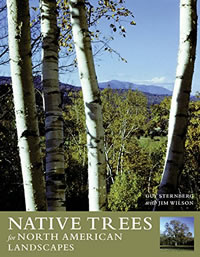
In Native Trees for North American Landscapes: From the Atlantic to the Rockies , the sub-title is very important as trees native only west of the Rockies are excluded. But almost all trees that are included can be found in the Arboretum, and many are widely planted in our region and are available in nurseries.
As the title suggests, authors Guy Sternberg and Jim Wilson address their book to gardeners and landscape designers, but there is also much here to interest those who love trees for their place in the natural landscape and as interwoven with human history. The quality and diversity of the photography is impressive, and well linked with the engaging text.
Excerpted from the Summer 2012 Arboretum Bulletin.
 Bamboo for Gardens is written by Washington State resident, Ted Meredith. While most of the photos are close-ups of their subject, it’s fun to see rhododendrons or a Douglas fir lurking in the background of wider shots.
Bamboo for Gardens is written by Washington State resident, Ted Meredith. While most of the photos are close-ups of their subject, it’s fun to see rhododendrons or a Douglas fir lurking in the background of wider shots.
Wherever you live, this would be an important and useful book. While there is the expected A-Z encyclopedia of species, it is unusual that the introductory material–such as culture, propagation, uses in the landscape–fills more than half the book. Some unexpected treasures can be found here, including the use of bamboo in both traditional and modern economies, and tips on eating bamboo.
You will learn, for example, that the shoots of Qiongzhuea tumidissinoda “are considered exceptional.” The fun continues in the encyclopedia section as we learn that this same, nearly unpronounceable species, which hails from central China, is harvested for walking sticks, and “…is the subject of history, myth, and fable in Chinese culture, dating back to at least the Han Dynasty in the first or second century B.C.”
While the author keeps the writing interesting, the more mundane information is very solid, including his discussions of how to deal with “…an attack from the demonic plant that invaded unexpectedly and ceaselessly, and could not be stopped or killed.” With the voice of experience and fondness that one might expect to be used on an errant puppy, Meredith carefully explains the different methods of containment for running bamboo.
Excerpted from the Summer 2012 Arboretum Bulletin.
 When first picking up the fascinating Life Histories of Cascadia Butterflies, I expected lots of lovely close-up photographs of our native butterflies. While I wasn’t disappointed, the majority of the photos are of the early stages of their life histories, i.e., lots of caterpillars! The thoroughness for depicting each species is outstanding with typically five or more photos of the different larval stages. How did authors David James and David Nunnallee do it? By rearing the butterflies from eggs and photographing each stage of their development.
When first picking up the fascinating Life Histories of Cascadia Butterflies, I expected lots of lovely close-up photographs of our native butterflies. While I wasn’t disappointed, the majority of the photos are of the early stages of their life histories, i.e., lots of caterpillars! The thoroughness for depicting each species is outstanding with typically five or more photos of the different larval stages. How did authors David James and David Nunnallee do it? By rearing the butterflies from eggs and photographing each stage of their development. Wild in the City is an invaluable guide for an exploration of the parks and trails in the Portland metropolitan area, but it’s quite readable even if you’re stuck somewhere else. Scattered amongst the trail maps and descriptions of various sites and walks are essays about wildlife, history–both natural and human–and the complexities of disturbed ecosystems, with a good dose of philosophy on the value of having nature in an urban setting. Over one hundred writers and illustrators have contributed to this fine work.
Wild in the City is an invaluable guide for an exploration of the parks and trails in the Portland metropolitan area, but it’s quite readable even if you’re stuck somewhere else. Scattered amongst the trail maps and descriptions of various sites and walks are essays about wildlife, history–both natural and human–and the complexities of disturbed ecosystems, with a good dose of philosophy on the value of having nature in an urban setting. Over one hundred writers and illustrators have contributed to this fine work. Nonnative Invasive Plants of Pacific Coast Forests is an unusual field guide that helps to identify plants you don’t want to find–but you probably will–especially in the forests of Washington, Oregon, and California. In various ways, these plants are negatively affecting our native plants, animals, and ecosystems. The intent of the authors is to make these recognizable to a larger audience beyond highly trained botanists. Many selections, such as purple loosestrife (Lythrum salicaria) and herb-robert (Geranium robertianum), are all too familiar to gardeners and visitors to the Arboretum. Others will be less familiar, or you might not know they are a problem, such as some of our popular cotoneasters (Cotoneaster franchetii and C. lacteus).
Nonnative Invasive Plants of Pacific Coast Forests is an unusual field guide that helps to identify plants you don’t want to find–but you probably will–especially in the forests of Washington, Oregon, and California. In various ways, these plants are negatively affecting our native plants, animals, and ecosystems. The intent of the authors is to make these recognizable to a larger audience beyond highly trained botanists. Many selections, such as purple loosestrife (Lythrum salicaria) and herb-robert (Geranium robertianum), are all too familiar to gardeners and visitors to the Arboretum. Others will be less familiar, or you might not know they are a problem, such as some of our popular cotoneasters (Cotoneaster franchetii and C. lacteus). Many of the over 7,000 vascular plant species of California described in The Jepson Manual can also be found in the Pacific Northwest.
Many of the over 7,000 vascular plant species of California described in The Jepson Manual can also be found in the Pacific Northwest. Flowers of Volunteer Park Conservatory is one of the best examples I’ve seen of a book capturing the spirit of a public garden. Photographer Sara L. Chapman has created monthly visual essays, using both close-ups and panoramas to bring you into the page and remind you of a real life visit. But this is more than just a picture book. The subjects of the photos are carefully captioned, making this a useful identification handbook to conservatory plants.
Flowers of Volunteer Park Conservatory is one of the best examples I’ve seen of a book capturing the spirit of a public garden. Photographer Sara L. Chapman has created monthly visual essays, using both close-ups and panoramas to bring you into the page and remind you of a real life visit. But this is more than just a picture book. The subjects of the photos are carefully captioned, making this a useful identification handbook to conservatory plants. Four Seasons on Bainbridge Island is a photo essay by Paul Brians celebrating the flora of the island, some from his own garden, and accented with a few shots of people, animals, and landscapes. Highly recommended for residents of Bainbridge, this book also captures the essence of semi-rural, island living anywhere around Puget Sound.
Four Seasons on Bainbridge Island is a photo essay by Paul Brians celebrating the flora of the island, some from his own garden, and accented with a few shots of people, animals, and landscapes. Highly recommended for residents of Bainbridge, this book also captures the essence of semi-rural, island living anywhere around Puget Sound. While you’re browsing the tables at your favorite plant sale or nursery, you may notice that many of the plant treasures tempting you have “henryi” or some similar variation in their name. In most cases, these honor Augustine Henry, the Irish customs official who worked for the Chinese government in western China during the 1880s and 1890s.
While you’re browsing the tables at your favorite plant sale or nursery, you may notice that many of the plant treasures tempting you have “henryi” or some similar variation in their name. In most cases, these honor Augustine Henry, the Irish customs official who worked for the Chinese government in western China during the 1880s and 1890s.
 Bamboo for Gardens is written by Washington State resident, Ted Meredith. While most of the photos are close-ups of their subject, it’s fun to see rhododendrons or a Douglas fir lurking in the background of wider shots.
Bamboo for Gardens is written by Washington State resident, Ted Meredith. While most of the photos are close-ups of their subject, it’s fun to see rhododendrons or a Douglas fir lurking in the background of wider shots.